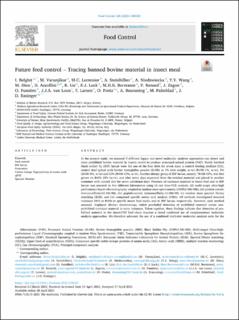| dc.description.abstract | In the present study, we assessed if different legacy and novel molecular analyses approaches can detect and trace prohibited bovine material in insects reared to produce processed animal protein (PAP). Newly hatched black soldier fly (BSF) larvae were fed one of the four diets for seven days; a control feeding medium (Ctl), control feed spiked with bovine hemoglobin powder (BvHb) at 1% (wet weight, w/w) (BvHb 1%, w/w), 5% (BvHb 5%, w/w) and 10% (BvHb 10%, w/w). Another dietary group of BSF larvae, namely *BvHb 10%, was first grown on BvHb 10% (w/w), and after seven days separated from the residual material and placed in another container with control diet for seven additional days. Presence of ruminant material in insect feed and in BSF larvae was assessed in five different laboratories using (i) real time-PCR analysis, (ii) multi-target ultra-high performance liquid chromatography coupled to tandem mass spectrometry (UHPLC-MS/MS), (iii) protein-centric immunoaffinity-LC-MS/MS, (iv) peptide-centric immunoaffinity-LC-MS/MS, (v) tandem mass spectral library matching (SLM), and (vi) compound specific amino acid analysis (CSIA). All methods investigated detected ruminant DNA or BvHb in specific insect feed media and in BSF larvae, respectively. However, each method assessed, displayed distinct shortcomings, which precluded detection of prohibited material versus non-prohibited ruminant material in some instances. Taken together, these findings indicate that detection of prohibited material in the insect-PAP feed chain requires a tiered combined use of complementary molecular analysis approaches. We therefore advocate the use of a combined multi-tier molecular analysis suite for the detection, differentiation and tracing of prohibited material in insect-PAP based feed chains and endorse ongoing efforts to extend the currently available battery of PAP detection approaches with MS based techniques and possibly δ13CAA fingerprinting. | en_US |
